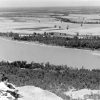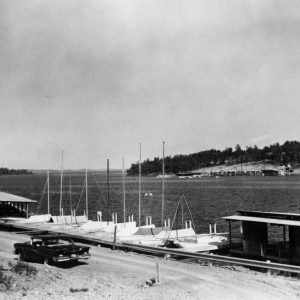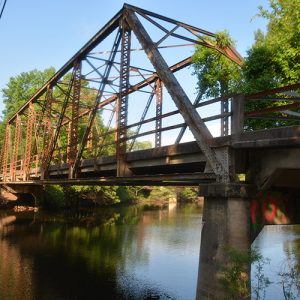calsfoundation@cals.org
Maumelle and Little Maumelle Rivers
aka: Lake Maumelle
The Maumelle River flows from small streams originating in the Ouachita National Forest in Perry County eastward to empty into the Arkansas River upstream from Little Rock (Pulaski County). Its most prominent feature is an 8,900-acre manmade lake, which supplies drinking water for ninety-five percent of the residents of Pulaski County.
The river is named for a rock formation in western Pulaski County. Now called Pinnacle Mountain, it was dubbed “Mamelle” by French explorers early in the nineteenth century for the French word for “breast.” The Maumelle River flows to the north of Pinnacle Mountain; a second river, called the Little Maumelle River, flows to the south of the same mountain. Some area residents refer to the Maumelle River as the “Big Maumelle River.” The city of Maumelle (Pulaski County), also named for Pinnacle Mountain, is north of the Arkansas River, several miles from the Maumelle River.
From their tributary creeks to their confluence with the Arkansas River, neither the Maumelle River nor the Little Maumelle River travels more than thirty miles. A few settlers were attracted to the well-irrigated land along the rivers in the nineteenth century, but they never developed a community to rival Little Rock, Crystal Hill (Pulaski County), or Cadron (Faulkner County).
As Little Rock and its suburbs grew after World War II, the water supply provided by Lake Winona in northwestern Saline County was seen as inadequate. Consequently, a dam was built on the Maumelle River, with construction beginning in 1956. Lake Maumelle was completed by 1958. When the river was dammed to create the lake, approximately fifty families had to move from the community of Crossroads (Pulaski County), which had schools, churches, and stores; the graves in the cemetery were moved. Many families relocated to the Roland (Pulaski County) and Natural Steps (Pulaski County) area near Highway 10.
Central Arkansas Water began overseeing the maintenance of the lake and watershed, and over the years, it has negotiated various agreements with property owners near the lake. Among other regulations, these agreements forbid the clearing of trees off the land; prohibit the development of hotels, condominiums, or restaurants near the lake; and require that property owners seek specific permission before beginning other kinds of construction. The agreement also bans the use of animal waste as fertilizer and provides financial incentives for septic tanks in the watershed to be replaced by sewer lines that carry household waste out of the area. Fishing and some boating are allowed on the lake, but swimming, wading, and many kinds of watercraft are forbidden.
The rivers and lake are home to various kinds of fish, including bass, crappie, bream, and catfish, as well as mussels and other aquatic life. Many birds and other wildlife also inhabit areas along the river, especially in the Ouachita National Forest. Increased protection of the environment along the river is provided by the U.S. Forest Service, which set aside $4 million in 2012 to protect four miles of forest along the river outside national forest. The Arkansas Game and Fish Commission has also created a wildlife management area (WMA) to protect the river and lake, signing a ninety-nine-year lease with Central Arkansas Water in 2013.
In 1992, the City of Little Rock and Pulaski County created a park of about 1,000 acres at the confluence of the Little Maumelle River and the Arkansas River. Named Two Rivers Park, the facility includes wooded wetlands; trails for walking, bicycling, and horseback riding; a “Garden of Trees”; and plots of ground available for small vegetable farms.
For additional information:
“Arkansas Game and Fish Agrees to 99-Year Lease on Maumelle River WMA.” ArkansasMatters.com. https://www.kark.com/news/ar-local/arkansas-game-fish-agrees-to-99-year-lease-on-maumelle-river-wma/ (accessed October 27, 2022).
Carey, Matthew Daniel. “Spatial and Temporal Water Quality Dynamics in the Lake Maumelle Reservoir: Geochemical and Planktonic Variance in a Drinking Water Source.” MS thesis, University of Arkansas at Little Rock, 2019.
Johnson, Dawn Marie. “Linking Land-Use and Water Quality Changes in Lake Maumelle through Benthic Sediment.” MS thesis, University of Arkansas at Little Rock, 2014.
Staff of the CALS Encyclopedia of Arkansas
 Geography and Geology
Geography and Geology Crossroads School
Crossroads School  Crossroads Store
Crossroads Store  Lake Maumelle
Lake Maumelle  Maumelle River Bridge
Maumelle River Bridge  Maumelle River Dam
Maumelle River Dam 



Comments
No comments on this entry yet.